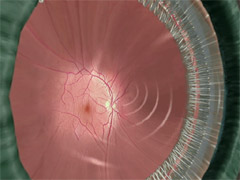
Eye and Vision Movies |
Vision and The Human EyeThese materials and much more can be found on our (Physiology Of The Eye CD-ROM) Anatomy of the Eye (Cross-sectional View)Click on the words in the list below to learn about the major structures of the eye. 
Color Theory and PerceptionWhat is color?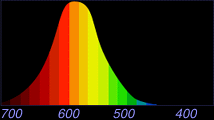
Red-sensing cones 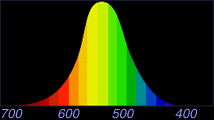
Green-sensing cones 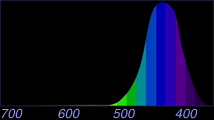
Blue-sensing cones Color is our perception of different wavelengths of light. Light visible to humans ranges in wavelength form 380 nanometers (nm) for violet light to 760 nm for red light. 
We have three types of cone photoreceptors. Each cone type responds to a different range of wavelengths within the visible light spectrum. Red-sensitive cones are most stimulated by light in the red to yellow range. Green-sensitive cones are maximally stimulated by light in the yellow to green range. Blue-sensitive cones are maximally stimulated by blue and violet light. Stimulation of different combinations of the three cone types can give the sensation of any color. The Additive Color Theory.Color vision in humans is based on the additive color theory. This theory states that all perceivable colors can be made by mixing different amounts of red, green, and blue light, the primary colors of the additive color system. 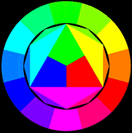
The additive color wheel. Equal amounts of the three primaries give the sensation of white, while the absence of additive primaries is black. Additive color theory explains what we see when we look at a luminant object such as a light bulb, a TV, or a computer monitor. An ordinary incandescent light bulb emits light over most of the visible spectrum, but is strongest in the red to yellow range. A standard "cool white" fluorescent bulb has a narrower emission profile than an incandescent bulb, producing more light in the green to blue range. The screen of a TV or a computer monitor is made of millions of red, green, and blue phosphors closely packed together. When stimulated by a high voltage, groups of phosphors glow to create an image on the screen. Millions of colors can be created by combining phosphors of these three primary colors. Optical IllusionsDo you see a white triangle defined by three black circles? Roll your mouse over the figure above to see how much of this perception is "real" and how much is imagined.A whiter-than-white triangle is clearly seen in Kanizsa's figure (above). Close inspection of this illusion reveals that there aren't any lines separating the triangle from the white background of the screen. Yet, a clear line is created in our minds. Figures defined by imaginary lines such as these are known as subjective contour illusions. One theory suggests that specialized contour-detecting cells in the brain are activated by these short line segments. Additional processing in the brain would "connect" the segments to form a continuous line. Subjective Illusions A subjective circle.  Do you see circles or squares? 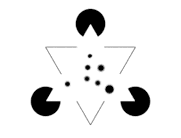 Do the black dots seem to float on top of the triangle?  A transparent surface is suggested by the subjective contour.  More eye and vision info... More eye and vision info...
|
 Flight into the Retina
Flight into the Retina The Lens
The Lens The Synapse
The Synapse Cataract Removal
Cataract Removal Macular Degeneration
Macular Degeneration Eye Development
Eye Development